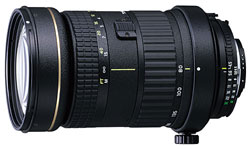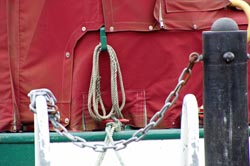Tokina AT-X 840 AF D 80-400mm f/4.5-5.6


This super-telephoto offering from Tokina costs £572, which makes it amongst the cheapest 400mm lenses available, as well as the smallest and lightest. Sigma offer a 120-400mm zoom, which costs around £607 and benefits from silent focusing and Optical Stabilisation.
Manufacturers own 400mm zooms include Canon's well-regarded 100-400mm IS USM, which costs £1228 and includes Images Stabilisation and Ultrasonic focusing. Nikon's 80-400mm is one of the older screw-driven auto-focus lenses, which costs £1165 and includes Vibration reduction.
Tokina AT-X 840 AF D 80-400mm f/4.5-5.6: Handling and features
Being roughly half the price of the manufacturer's 400mm zooms, the Tokina is an interesting lens that will appeal to many due to its small size and light weight. Being about the same size and only slightly heavier than a typical 70-300mm zoom, this lens should make a great travel companion for those wishing to pack longer focal lengths but travel light. On a crop-sensor camera, this lens gives the equivalent field of view of a 120-600mm lens, which is ideal for wildlfe.
Features-wise, it is fairly basic. There is no optical stabilisation included and focusing is powered by a standard micro-motor on the Canon version and is screw-driven on the Nikon version. This means the lens will not auto-focus on entry-level Nikon bodies such as the D3000 or D5000. Autofocus is quite slow, which may pose problems when attempting to track moving subjects and it tends to hunt around quite a lot, especially at the long end of the zoom, even is relatively good light.
The fit and finish of the lens is quite good. It feels reassuringly well put together. The lens barrel is finished in hammer-finish paint, which appears quite tough and doesn't mark too easily. Deeply knurled rubber grips on the focus and zoom rings give good grip, even when using gloves and the zoom action is nice and smooth, although it does tighten up a little at the long end. A zoom lock is provided to fix the zoom at 80mm during transport, but nothing is provided to prevent zoom creep when using the lens on a tripod, which is something this lens does suffer with unfortunately. Care needs to be taken to hold the zoom in position when pointing the lens downwards as the large front element has a habit of pulling the zoom forward.
A non-removable tripod collar is provided so that the camera and lens balance better when mounted on a support. It would've been nice to be able to remove this from the lens as it covers the zoom ring and I found it could get in the way sometimes. Still it does its job quite well and is quite necessary on a lens like this.
A deep, flock-lined circular lens hood is supplied to sheild the front element of the lens from extraneous light. A rubber thumb wheel has been incorporated into the design which allows for easy rotation of a polariser with the lens hood attached, which is a great idea and a nice design touch.
Tokina AT-X 840 AF D 80-400mm f/4.5-5.6: Performance
For this review, the lens was tested on a 12Mp Nikon D700 using Imatest.
At 80mm, this lens is capable of producing images of good resolution, and produces the sharpest results between F/5.6 and F/8. As with many zoom lenses, the resolution starts to drop as the focal length is increased. By 200mm, the resolution will still be acceptable for many applications but the sweet spot for sharpness has moved down to F/16, which will require a lot of light to get hand-holdable shutter speeds. This pattern continues at 400mm, with the resolution dropping off quite a bit more and the sweet spot for sharpness now at f/22. Here the resolution will be just about acceptable for most, so a sturdy tripod will be a good companion for this lens.
Tokina AT-X 840 AF D 80-400mm f/4.5-5.6: Resolution at 80mm

Tokina AT-X 840 AF D 80-400mm f/4.5-5.6: Resolution at 200mm

Tokina AT-X 840 AF D 80-400mm f/4.5-5.6: Resolution at 400mm

Chromatic Aberrations are well within acceptable levels at 80mm on this lens. At their worst, they cover just over half a pixels width, which will be barely visible in most images. Just as with the resolution characteristic, colour fringing becomes more prominent as the lens is zoomed in. By 200mm, chromatic aberrations exceed 1pixels width, which will start to become visible, but is still acceptable. At 400mm, things the colour fringing has become quite strong and will be easily noticed in high-contrast images, exceeding 3.5pixel widths at their worst and approaching 2.5pixel widths at their best. The values are so high, I had to adjust the scale of the graph for the values at 400mm.
Tokina AT-X 840 AF D 80-400mm f/4.5-5.6: Chromatic Aberrations at 80mm

Tokina AT-X 840 AF D 80-400mm f/4.5-5.6: Chromatic Aberrations at 200mm

Tokina AT-X 840 AF D 80-400mm f/4.5-5.6: Chromatic Aberrations at 400mm

Light falloff isn't much of an issue at 80mm, with the corners being just over a stop darker than the image centre. Illumination is even by F/8 at this focal length. Falloff increases a little at 400mm, but is still acceptable, with the comers being 1.9 stops darker than the image centre. Illumination is even by F/11.
Distortion is well controlled at 80mm, with Imatest only recording 0.35% barrel distortion, which should barely be visible in most images. By 400mm, the barrel distortion has been traded for nearly 2% pincushion distortion, which is an acceptable amount for such a zoom, and is easily corrected in image editing software.
 |  |
 |  |
Flare and ghosting is well controlled by this lens. Strong point sources of light can cause a linear flare pattern across the image area, but only in exceptional circumstances, The supplied hood does a sterling job of shielding the front element, ensuring contrast is retained well.
Tokina AT-X 840 AF D 80-400mm f/4.5-5.6: Verdict
Although this is not the highest performing lens tested, it may still appeal to those looking for a compact super-telephoto for travel as its compact size and light weight are certainly appealing features. It is priced keenly too, so may appeal to photographers after that extra bit of length who have to work to a budget.
So long as the limitations of this optic are taken into account, it can yield good results in the right situations although those looking for the very best image quality may find the resolution at longer focal lengths limiting.
Tokina AT-X 840 AF D 80-400mm f/4.5-5.6: Pros
 Compact size
Compact size Light weight for a 400mm
Light weight for a 400mm Excellent lens hood design
Excellent lens hood designTokina AT-X 840 AF D 80-400mm f/4.5-5.6: Cons
 Resolution at 400mm
Resolution at 400mm Chromatic Aberrations at 400mm
Chromatic Aberrations at 400mm Slow auto-focus
Slow auto-focus Non-removable tripod collar can get in the way when zooming
Non-removable tripod collar can get in the way when zooming| Features |  |
| Handling |  |
| Performance |  |
| Value for money |  |
| Overall |  |
Tokina AT-X 840 AF D 80-400mm f/4.5-5.6: Lens specification
| Price: | £572 |
| Contact: | http://www.tokinalens.com |
| Filter size: | 72mm |
| Format: | Full frame |
| Construction: | 16 elements in 10 groups |
| Angle-of-view: | 29° 50’ to 6°13’ |
| 35mm equivalent focal length (on APS-C body): | 120-600mm |
| Internal focusing: | No |
| Image stabilisation: | No |
| Minimum focus: | 250cm |
| Maximum aperture: | f/4.5-5.6 |
| Minimum aperture: | f/32-40 |
| Weight: | 1020g |
| Size (lxw): | 136.5mm x 79mm |
| In the box: | Lens Hood |
The Tokina AT-X 840 AF D 80-400mm f/4.5-5.6 lens costs £572 and is available from Warehouse Express here:
Tokina AT-X 840 AF D 80-400mm f/4.5-5.6 - Nikon Fit
Tokina AT-X 840 AF D 80-400mm f/4.5-5.6 - Canon Fit
Add your message
Login required
Please login here or if you've not registered, you can register here. Registering is safe, quick and free.
Please login here or if you've not registered, you can register here. Registering is safe, quick and free.
photodo Stats
1102 lenses
428 MTF tests
74 in-depth photodo reviews
100+ users join each day
Help the lens community by reviewing or rating a lens today via our lens search
428 MTF tests
74 in-depth photodo reviews
100+ users join each day
Help the lens community by reviewing or rating a lens today via our lens search
Latest Lens Reviews
- Chinon 28mm f/2.8 Vintage Lens Review
- Canon EF 70-200mm f/4L IS II USM Lens Review
- Samyang AF 85mm f/1.4 EF Review
- Sigma 70mm f/2.8 DG Macro Art Review
- Samyang AF 24mm f/2.8 FE Review
- Meike 50mm f/1.7 Review
- Tamron 70-210mm f/4 Di VC USD Review
- Lensbaby Burnside 35mm f/2.8 Review
- Asahi Super Takumar 50mm f/1.4 Review
- Asahi Super-Multi-Coated Takumar 135mm f/3.5 Review
